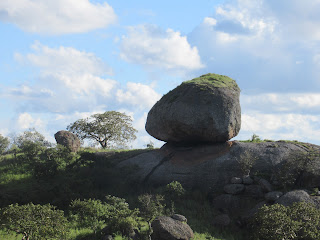Kulundala Falls and Piedra Noire, Angola
Before we left Luanda, we visited the Slave Museum. It is housed in the original building the ot=rganised the slave trade and shipping of slaves from the harbour next door. Between 12m - 20m slaves were shipped from Africa and about 4m from Angola.
The Slave Museum on a hill overlooking the harbour.
One of the large cauldrons used to boil sugar pulp to make sugar.The entrance to the slave port.
And then we drove inland from Luanda to see some natural wonders.
In the distance is the Kalandala Falls, the third largest in Africa.Looking over the edge of the falls and not a position I wanted to spend any more time than necessary as I don't like heights.
A view of the water cascading over the edge from a viewpoint.
I took a long winding steep path through some steamy jungle to a photo of the falls looking up from near its base.
And then a drive towards Piedra Noire, seen here in the distance on the horizon. They are a collection of tall blocks of rocks standing proud above the surrounding landscape. They are made of a conglomerate, a number of different rocks that have been weathered, swept here in a giant flood and then some mineralisation has bound them together. They are more resistant to erosion than the surrounding rocks which have been eroded to leave these curious forms.Some closer views.
In the centre of the formation was a former Portuguese army post. The buildings had been converted to a school but the nearest settlement isomer ten kilometres away. Now it is a camp site and police post. One of the colonial buildings although much of the site is in disrepair.
An anthill on the path up to the top of the rocks.
A view from the mirador over the formations.
A view back to the bowl where the camp site is situated.
Another top of one of the rocks.
A balancing rock.
And then it was back on the road. We came to some tarmac roads and even a dual carriageway but like many things in Africa, it wasn't finished.
An anthill on the path up to the top of the rocks.
A view from the mirador over the formations.
A view back to the bowl where the camp site is situated.
Another top of one of the rocks.
A balancing rock.
And then it was back on the road. We came to some tarmac roads and even a dual carriageway but like many things in Africa, it wasn't finished.
And then as abruptly as it had started the dual carriageway finished and we were back to dirt tracks on our way south to cross the border into Namibia..
But going slowly meant that it was easier to spot wood for fuel. So we would stop and gather dry dead wood from the roadside. Some bits are bigger than you can break up into smaller pieces to fit in the wood locker, so Gareth got out the chain saw and cut up a fallen tree into more manageable pieces.




















No comments:
Post a Comment